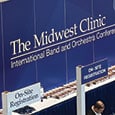Each year brings a new crop of eager beginning students. Directors have a wonderful opportunity to establish good rehearsal habits right from the start and avoid much frustration as they progress. For example, if students in advanced groups are required to have a pencil on their stand in rehearsal, then beginners should too.
Listening Skills
The ability to listen to and then follow instructions or respond to correction is maybe the most vital habit for successful rehearsals. Good listening skills are a result of habit just as much as posture and breathing. To promote this in beginners, teachers first should have the attention of the class. It is common for directors to talk over noise in the rehearsal room, and much of what they say is lost. Especially early in the year, take a second or two to let the room quiet before delivering information. Insist from the start that students look at you while you talk. Later in the first semester, it may be appropriate to tell them that they may look at you or the music, depending on what is being discussed.
In my experience young students, especially boys, treat their instruments like giant Erector sets when they are not playing. Brass players pull tuning slides out and unscrew valve buttons and caps, while woodwind players click keys and unscrew ligatures. This behavior distracts not just the student who is playing around, but also students on either side. Teach them a standard rest position that they are expected to use, with instruments on the knee or across the lap and hands and fingers in playing position. This will go a long way toward eliminating distracting behavior.
Another way to promote good listening is to occasionally pick a student at random and ask what was just said. A correct response earns praise or a small reward. If the student gives a wrong answer or has no idea what was said go to the next student down in the seating order. If this student responds correctly, have the students switch places. It is a good idea to warn students before employing this practice; the goal is not to punish students, but to encourage everyone to pay attention.
Organization
Organizational skills should also be emphasized from the first day. Students should keep all hand-outs, music, pencils, and the method book in a binder. This keeps them organized in class and makes it easy to take these materials home each day to practice.
Periodic checks of binders emphasizes the importance of keeping them organized. If students do not have the binder in class when new materials are passed out, hold music until they bring the binder to class. Write the student’s name at the top of the hand-out or music and keep it in a folder. This does add another administrative duty, but it goes a long way toward showing students how important it is to have everything in rehearsal each day.
I find that it is more effective to make sure students have a reason to use a pencil than to take points off a grade when they do not have one. For example, to promote pencil use, ask students to make notes when corrections are made in class. If the teacher discusses the importance of holding notes before rests for full value, students should mark arrows above the notes or draw a line to the rest. The more students are required to use pencils in class, the more likely they are to have one available.
As a side note, I do not advocate writing in note names with beginning band. This encourages students to read letters rather than identifying notes by their placement on the staff. I also do not allow students to write in fingerings unless they are new or unfamiliar alternate fingerings (such as side C in the saxophone, fork B in the clarinet, or lever B flat in the flute). At first I have trumpets mark when to use the third valve slide on low D, and I ask trombones to mark when to use shorter positions in the fifth harmonic.
Learning to Watch
Because of the way most beginning bands are taught, there is little conducting during the first year, with the exception of a few performances. As students move into more advanced performing groups though, it can be frustrating to encourage the practice of looking up from the music at the conductor unless this habit has been introduced and encouraged during the first year.
One exercise is for the teacher to stand at the front of the room while students count or play a line while they read music. As students play, the teacher holds up several fingers, makes a shape with the fingers, or holds up signs with colors, words, or letters. After students have completed the music, ask a student how many fingers were held up or what was on the card. Another option is to ask everyone to close their eyes and hold up the same number or make the shape with their fingers. Later, as conducting is incorporated, the director can show numbers or shapes with the hand that does not hold the baton and then question students as described.





